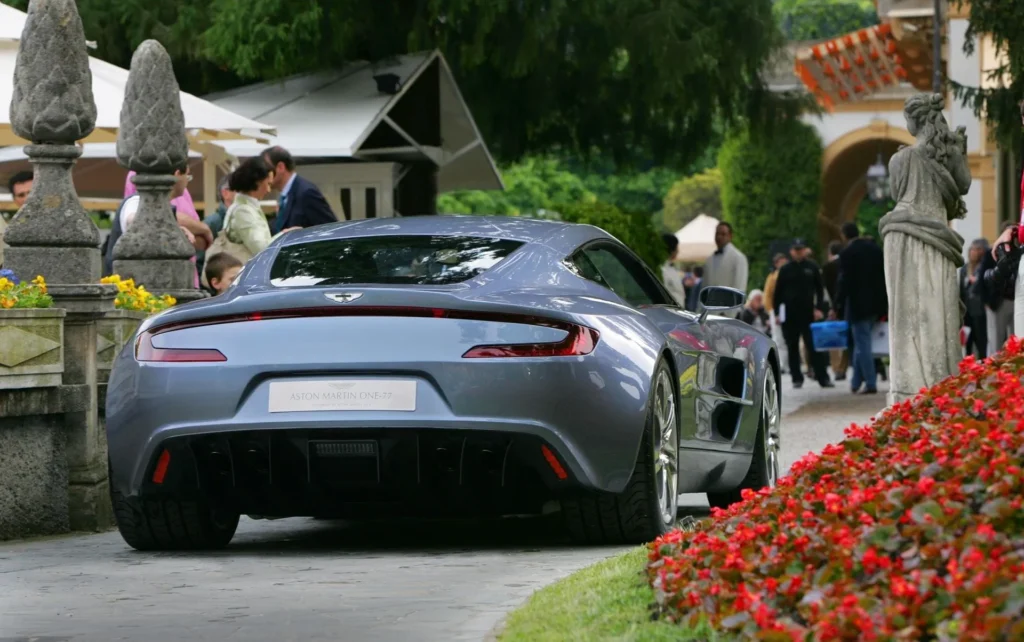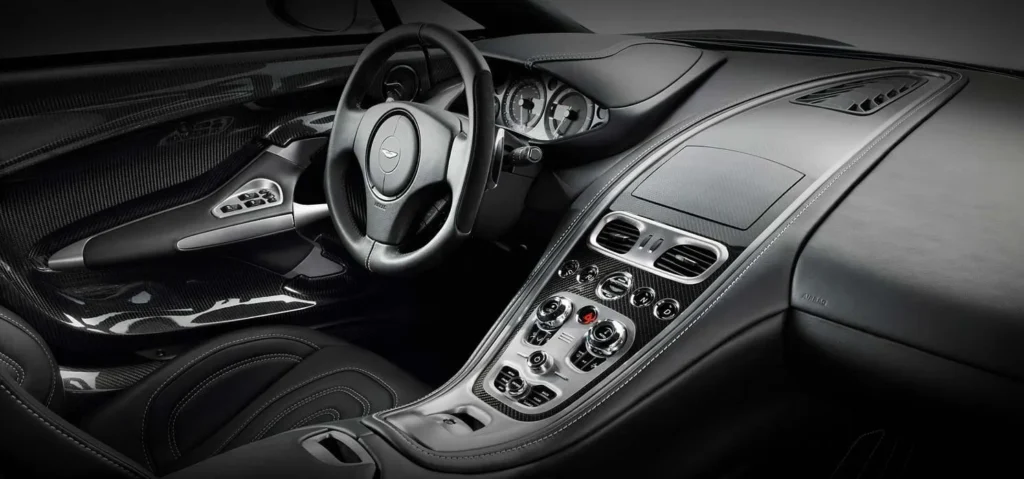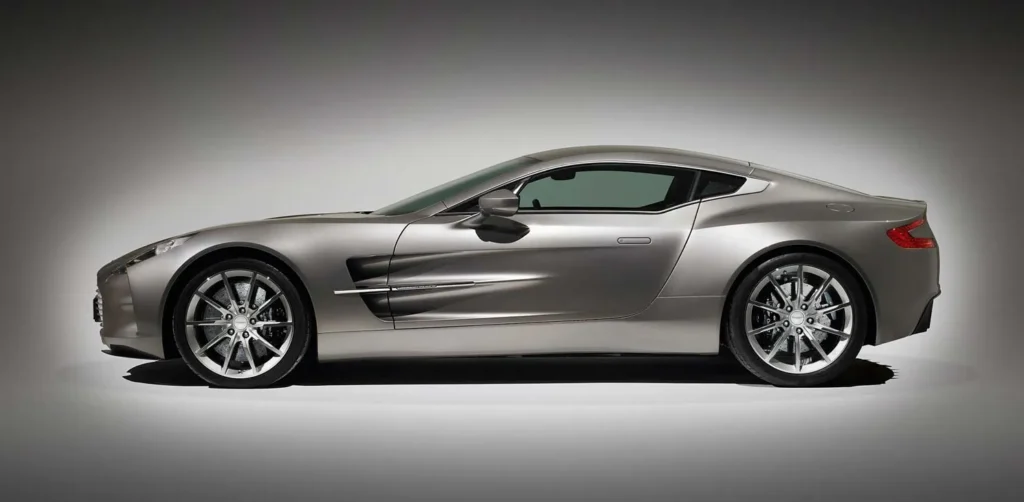Origins and Inspiration
The One-77 sprang from Aston Martin’s wild ambition to flex their engineering muscles and design chops. They wanted to show the world what they could pull off when they ignored the usual rules of mass production.
This car wasn’t just another pretty face at the auto shows—it was a thunderous announcement. The British automaker rolled it out to stunned crowds and, honestly, it was hard not to stare.
Purpose and Vision Behind the One-77
Aston Martin built the One-77 not for profit, but for pride. They chased the idea of a flagship that could cram all their know-how into a single, jaw-dropping machine.
The One-77 wasn’t built for the masses or to make money. Instead, it became a rolling testament to Aston Martin’s engineering excellence. It screamed, “Look what we can do if you just let us off the leash.”
The vision? To create one of the earliest true hypercars. With a price tag of around £1.15 million (about $1.9 million at launch), the One-77 wasn’t about margins—it was about making a statement.
Each car soaked up roughly 2,700 man hours to build. Compare that to 60 hours for a Porsche 911 and you start to realize just how obsessive Aston Martin got about every detail.
Inspirations Driving Development
The team drew fuel from Aston Martin’s racing legacy and their love of hand-built artistry. They followed the golden ratio, letting math and beauty dance together in the car’s proportions.
Race tech bled into the One-77’s bones. The pushrod suspension, with its bell-cranks and horizontal dampers, felt straight out of a Le Mans pit lane. Less unsprung mass, quicker wheel response—it’s all about that razor-sharp handling.
They shaped the all-aluminum body by hand, beating out panels until the rear looked like liquid metal—no shut lines, just endless flow. If you love old-school craftsmanship, it’s honestly poetic.
Under the hood, the naturally aspirated 7.3-liter V12 (Cosworth had a hand in it) howled up to 7,500 rpm. No turbos—just pure, old-school drama and that visceral, spine-tingling soundtrack Aston Martin adores.
Debut Events and Public Reaction
The One-77 strutted onto the scene at the 2008 Paris Motor Show. People didn’t just look—they gawked. The car’s wild proportions and aggressive stance turned heads everywhere.
At 2,204mm wide (mirrors out), it practically bullied other cars off the show floor. That seamless metalwork? It looked like sculpture on wheels.
By the 2009 Geneva Motor Show, Aston Martin showed the production version and dropped the price bomb: £1.15 million. That put the One-77 in the rarest of air—back then, hardly any cars dared cross the £1 million line.
Only 77 would ever exist. Collectors and dreamers alike started scrambling. You could almost feel the exclusivity in the air.
Behind-the-Scenes Stories
Ten prototypes led the charge during development. One of them, chassis #10711, lived a wild life—tested at Nürburgring, Le Mans, and Nardo, then reborn as a street-legal unicorn.
They called it the “78th” One-77—a nod to its second chance at glory. It’s a little reminder of just how deep Aston Martin’s commitment went.
The engineers even had fun with it. The dampers? They cranked up to 11, just like in Spinal Tap. The boot? Barely fit a toothbrush, but who cares—this thing was built for speed, not suitcases.
And near the finish line, Aston Martin whipped up seven Q Series cars—each one a bespoke, final flourish before the curtain fell. If that doesn’t sound dramatic, I don’t know what does.
Technical Masterpiece: Engine and Performance
The Aston Martin One-77, honestly, is British engineering at its most unfiltered. It’s got a naturally aspirated 7.3-liter V12—no turbos, just raw muscle—bolted to a carbon fiber chassis that weighs less than a big dog. The whole thing feels like a love letter to speed and artistry.
7.3 Litre V12 Engine Architecture
The heart of the One-77 is that glorious 7.3-liter V12, pushing out a whopping 750 horsepower at 7,500 rpm and 553 lb-ft of torque at 5,750 rpm. It’s the most powerful naturally aspirated engine Aston Martin ever built.
It’s a proper old-school engine, but packed with clever tricks:
- Dry sump lubrication—oil stays put, even during wild cornering
- Individual throttle bodies for each cylinder—snappy response, always
- Titanium rods and forged pistons—less weight, more revs
- Variable valve timing—keeps things punchy across the rev range
It loves to rev, hitting a redline at 7,500 rpm. The titanium exhaust? It sings—loud, sharp, and absolutely unforgettable.
Regarding the titanium exhaust, just take a listen to how marvelous it sounds
They shaved every ounce they could—magnesium intakes, carbon fiber covers. The whole engine weighs just 454 pounds. For something this mighty, that’s almost poetic.
Carbon Fibre Monocoque and Chassis
The One-77 rides on a full carbon fiber monocoque that tips the scales at just 220 pounds. That’s lighter than most gym equipment, and it makes the car ridiculously stiff and safe.
Key chassis specs:
| Component | Material | Weight |
|---|---|---|
| Monocoque | Carbon fiber | 220 lbs |
| Body panels | Aluminum | Not specified |
| Suspension | Aluminum/Carbon | 89 lbs |
The frame packs in a roll cage and honeycomb core where it matters most. Carbon body panels are glued straight to the chassis—no bolts, just aerospace-level bonding.
Suspension? Adaptive dampers, double wishbones up front, multi-link at the back. You can tweak the settings, but honestly, it’s sharp even in default mode.
Transmission and Drivetrain
The One-77 uses a six-speed automated manual gearbox—single-clutch, not dual. It’s a bit old-school, but it bangs through gears in about 200 milliseconds if you push it. Not the smoothest, but it feels mechanical, almost alive.
There are three driving modes: Normal, Sport, and Track. Each changes the shift speed and throttle response, so you can dial up the drama or keep things civilized—if you ever want to.
All the power goes to the rear wheels through a limited-slip diff. Traction control and stability systems are there, but you can switch them off if you’re brave (or foolish).
Launch control helps you rocket from 0 to 60 mph in just 3.5 seconds. Top speed? 220 mph, give or take. It’s not just fast—it feels like it wants to bend the laws of physics.
Exterior, Interior, and Aerodynamics
The Aston Martin One-77 is a rolling sculpture. Every curve whispers of speed, but there’s elegance too—like a tailored suit with a hidden blade. It’s both art and weapon, and honestly, it’s hard not to fall in love with how beautiful it looks.
Exterior Design Language

The One-77’s skin is pure Aston—long hood, short overhangs, and that signature grille. The lines flow like water, but there’s muscle underneath. It’s classic, but also kind of futuristic.
Up front, that grille nods to the brand’s past, while the LED headlights add a modern glare. It’s bold, but not shouty.
Key Design Elements:
- Sculpted vents that breathe and cool
- Wide rear haunches—looks ready to pounce
- Integrated spoilers
- Carbon accents everywhere
From the side, you see how every crease is there for a reason. It’s not just for show—it’s all about slicing through the air.
The rear? Diffuser, subtle wing, and those signature tail lights. It’s dramatic, but never overdone.

Handcrafted Interior Features
Inside, the One-77 is a blend of luxury and racecar. Leather everywhere, stitched by hand—it’s tactile, warm, and smells incredible.
Carbon fiber trim adds a modern edge. The steering wheel has alcantara grips and puts every control right at your fingertips.

Interior Highlights:
- Seats: Carbon shells wrapped in leather—supportive but surprisingly comfy
- Dashboard: Curved, with digital displays that never overwhelm
- Center Console: Minimalist—just the essentials
- Door Panels: Sculpted, with a bit of storage (not much, but who cares?)
Everything’s angled toward the driver. The digital cluster is crisp, but not distracting. It’s intimate, focused, and there’s just enough storage for a phone and wallet. Passenger comfort? Not really the point here.
Aerodynamic Innovations
The One-77 is a masterclass in airflow. Every vent, curve, and edge has a job to do—either slicing through the wind or pinning the car to the tarmac.

Active aero pieces adjust on the fly. The front splitter and rear wing work together, shifting to keep the car planted at any speed.
Aerodynamic Features:
- Venturi tunnels: Suck air under the car for extra grip
- Active rear wing: Moves with speed, always optimizing
- Front splitter: Adds downforce up front
- Side vents: Let the air escape from the wheel wells
They ran endless simulations—computational fluid dynamics, wind tunnels, the works. The underbody channels air where it’s needed most, so you get downforce without the drag penalty.
The result? Cornering that feels glued, and a top speed that doesn’t come with nasty surprises. It’s a balancing act, and Aston Martin nailed it.
Special Editions and Production Variants
The Aston Martin One-77 kept things exclusive—just 77 cars, no official special editions. But each one? Custom-spec’d right from the factory, so no two are exactly alike. That’s real exclusivity, and it’s part of what makes the One-77 such a legend.
Limited Production Run
Aston Martin built exactly 77 units of the One-77 hypercar between 2009 and 2012. They picked that number on purpose—it’s almost poetic, isn’t it?—just to crank up the exclusivity in the luxury car world.
Production actually kicked off in 2009 after the concept wowed crowds in 2008. Each One-77 took about 2,700 hours to assemble by hand at the Gaydon, England, facility—a true labor of love.
The first five cars? Those were prototypes and testbeds. The real deal—cars 6 through 77—ended up in garages all around the globe.
Production Timeline:
- 2009: Final design approval
- 2010: Pre-production testing
- 2011: Customer deliveries begin
- 2012: Final unit completed
After car number 77 rolled out, that was it. No more. Aston Martin loves a good limited edition, but the One-77? That one’s the rarest bird in their flock.
Unique Specifications Per Model
Every One-77 came with a bespoke vibe—interior, exterior, you name it. Aston Martin’s Q division handled every custom request, making sure each owner could flex their style.
Standard Customization Options:
- Paint colors: Over 20 exclusive finishes
- Interior leather: Multiple hide types and shades
- Carbon fiber: Exposed or painted, take your pick
- Wheel finishes: A bunch of metal treatments
Some owners went wild with unique paint and cabin combos. That kind of customization? It could stretch your wait time by 6 to 12 months. Worth it, though, right?
Each car had its own chassis number and a fat stack of build docs. Aston Martin kept detailed records for every single One-77—authenticity is king in this world.
Mechanically, though, all 77 shared the same heart: a 7.3-liter naturally aspirated V12, a carbon fiber monocoque, and a racing-bred suspension. No shortcuts, just pure performance poetry.
This approach meant every One-77 was a one-off masterpiece, not just another face in the crowd. Each car? A brushstroke in automotive history—beautiful, rare, and unforgettable.
Records, Recognition, and Competitive Landscape
The Aston Martin One-77 didn’t just show up—it made an entrance. It carved out a spot for itself among hypercars, going toe-to-toe with legends from McLaren and Ferrari.
Lap Records and Performance Benchmarks
The One-77 is one of the fastest cars in the Aston Martin lineup, but unfortunately, we can’t really determine how fast it goes around a race track since an official lap record was never published around the Nordschleife.
Key Performance Metrics:
- 0-60 mph: 3.5 seconds
- Top speed: 220 mph
- Quarter-mile: 11.0 seconds
- Braking 60-0 mph: 101 feet
It showed off at Silverstone too, lapping in 1:25.6. That’s quick enough to make even Ferrari and McLaren owners sweat a little.
Pro drivers raved about the One-77’s cornering grip and how it just rockets down the straights. The aero? It’s not just for show—it keeps those lap times tight, rain or shine.
Awards and Distinctions
When the One-77 dropped, the world noticed. It snagged a Top Gear Beauty of the Year nod in its debut, thanks to its blend of unique design and simplicity
It earned high praise from publications like Car and Driver, calling out the adaptive suspension and the way it somehow made 750 horsepower feel civilised for the street. It’s a unicorn, really.
At the Goodwood Festival of Speed, the One-77 turned heads and took home the Hypercar Hill Climb Challenge. That’s bragging rights, plain and simple.
The One-77 won the prestigious Concorso d’Eleganza Villa d’Este Design Award, which is a major accolade worth mentioning.
Rival Hypercars and Market Context
The One-77 went up against the likes of the McLaren 720S and Ferrari F8 Tributo. Those are some serious heavy hitters, and the One-77 didn’t flinch.
Main Competitors:
- McLaren 720S: 710 hp, 2.9-second 0-60 mph
- Ferrari F8 Tributo: 710 hp, 2.9-second 0-60 mph
- Lamborghini Huracán EVO: 640 hp, 2.9-second 0-60 mph
The One-77’s price tag? It made the McLaren and Ferrari look downright accessible. Aston Martin’s rivals had the numbers, but the One-77 had the soul—and that British swagger you just can’t fake.
If you wanted heritage and modern performance, the One-77 was your ticket. It stood out from the Italian and German crowd, especially among classic car collectors who crave something different.
And let’s be honest—the scarcity of just 77 cars? That’s the kind of rarity that makes collectors lose sleep at night. It’s not just a car; it’s a legend in the making.
Pricing, Market Value, and Legacy
The Aston Martin One-77 isn’t just a car—it’s a milestone for collectors, a shining star in the world of automotive dreams. Its price and value tell a story of luxury, rarity, and the thrill of the chase. You can almost feel the excitement in the air at auctions, can’t you?
Original Pricing and Collectability
When brand new, the One-77 wore a price tag of around$1.8 million—give or take, depending on how wild you went with the options. That’s the kind of sticker shock that makes your heart skip a beat.
With only 77 built, collectors instantly pegged it as a future blue-chip. No mass production here—just a handful of cars for the world’s lucky few.
Early buyers saw the writing on the wall. Most cars ended up hidden away in climate-controlled garages, barely driven. Who’d risk a scratch on something this rare?
Aston Martin aimed the One-77 right at Ferrari and Lamborghini, but with a British twist. It’s like comparing Savile Row tailoring to Italian couture—both stunning, but each with its own magic.
Current Market Value Trends
These days, the One-77 has become even hotter. Well-kept examples fetch anywhere from $2.5 million to over $3 million at auction—sometimes more if the car’s got a cool story or special paint.
If you’ve got one with less than 1,000 miles? Expect to see the price climb even higher. Collectors love a “time capsule” car.
According to used car market trends, demand for the One-77 is only growing. Economic ups and downs barely make a dent—rarity and passion always win out.
Condition is everything. Original paint, perfect service history, and matching-numbers engines send prices soaring. That’s just the way the collector world spins.
Europe and North America tend to see the highest prices, but honestly, if you want a One-77, you’ll chase it anywhere. It’s a symphony of design and engineering—beautiful, dramatic, and utterly unforgettable.
Brand Impact and Long-Term Legacy
The Aston Martin One-77? Now that’s a car that truly put the brand on the map for ultra-rare masterpieces. With only 77 ever built, it shouted exclusivity and set a new standard for special editions—honestly, it’s like the crown jewel in their collection.
Its impact still echoes today. You can see design cues from the One-77 in almost every modern Aston Martin.
What’s wild is how the One-77’s tech—like its carbon fiber monocoque, advanced aerodynamics, and that beastly 7.3-liter naturally aspirated V12 engine—ended up shaping the rest of the lineup. Later models borrowed its engine management systems, and the focus on lightweight materials became an Aston signature.
Collectors? They go absolutely nuts for the One-77. There are whole communities and owner clubs who geek out over every detail, swapping stories and tips on keeping these beauties pristine.
Even in marketing, Aston Martin can’t resist name-dropping the One-77. They love to reference its track records and racing-inspired engineering—who wouldn’t, with a car that could hit 220 mph and rocket from 0-60 in about 3.5 seconds? It’s become a legend, a kind of mythic beast that still gives the brand its edge.
And the design philosophy? That blend of raw performance and lavish luxury—pure poetry on wheels. It’s like the One-77 wrote the playbook for every high-performance Aston Martin that followed. If you ask me, few cars sound as beautiful as the One-77 looks—and that’s saying something.
Final Words
The Aston Martin One‑77 is more than a car—it is a statement of rarity, craftsmanship, and raw emotion. With only 77 ever created, it represents the pinnacle of exclusivity, blending timeless British design with a ferocious 7.3‑liter V12 that redefines performance. Every curve, every detail, speaks of artistry reserved for the fortunate few who can experience it. The One‑77 is not just driven; it is cherished, admired, and remembered as one of Aston Martin’s greatest achievements. For collectors and dreamers alike, it remains a legend—untouchable, unforgettable, and destined to inspire for generations.
Thanks for reading! If you enjoyed this deep dive, be sure to subscribe to my email list for exclusive car reviews, insider tips, and weekly special offers on car parts, auctions, and gear — perfect for any car enthusiast.
If you have any thoughts or experiences with this car? Leave a comment below — I love hearing your opinions and sparking conversations with fellow enthusiasts.
And don’t forget to read related posts for more great content!





[…] design borrows a bit from the Aston Martin Vulcan, One-77, and CC-100. They used bigger carbon fibre panels with fewer seams to keep the lines clean and the […]
[…] Aston Martin One-77 Market Values […]
[…] luxury bruiser was gunning for the Bentley Bentayga and Rolls-Royce Cullinan. Its handbuilt nature meant each one would’ve been truly […]
[…] captured everything that made the Plus 8 special—old-school British craftsmanship, muscular V8 performance, and a lightweight chassis that barely changed in fifty […]